Master Suno prompt examples with our quick guide. Elevate your skills and understanding with our expert tips and insights.
PermalinkKey Highlights
Introduction to Suno Prompts: Explanation of how Suno uses AI to create music based on user text prompts, specifying style, mood, instruments, and more.
Importance of Suno Prompts: How mastering Suno prompts unlocks creative possibilities and allows greater control over music creation.
AI in Music Creation: Insights into how AI personalizes and enhances music production.
Types of Suno Prompts: Examples of various styles, genres, and song types that can be used in prompts.
How to Craft Suno Prompts: Provide instructions for creating effective prompts, including choosing genres, adding cultural/emotional elements, and fine-tuning with instruments and rhythms.
Developing an AI Music Prompt Generator: Overview of integrating Novita AI’s LLM services to create an AI music prompt tool.
PermalinkIntroduction
Suno transforms music creation with AI technology. Users input text prompts to generate music in various styles and moods. Mastering Suno prompts unlocks endless creative possibilities for all musicians. Learn how to craft effective prompts and enhance creativity, whether you’re a seasoned musician or exploring new sounds. Explore AI’s role in music creation and step-by-step guides and examples to optimize your process. Discover how Novita AI’s LLM API services can help create unique music prompts, from selecting genres to seamless music generation. Start your musical journey with this exciting tool!
PermalinkUnderstanding the Basics of Suno Prompts
Suno prompts guide AI in music creation with instructions or keywords, specifying type, mood, and instruments to spark creativity. The “Custom Mode” allows users to control lyrics and styles for better accuracy. Mastering these prompts unlocks creative possibilities for both clear visions and new ideas.
PermalinkWhat is Suno Prompt
Suno is an AI platform that creates music, including songs with vocals and instrumentation based on text prompts. It allows users to produce music by describing style, mood, or lyrics.
Suno prompts are a tool that uses a large language model to convert style prompts into music, allowing you to input themes or custom lyrics along with styles or genres.
PermalinkHow does AI in Music Creation
Personalization and Creativity: AI music generation is changing how we make and enjoy music. Tools like Suno are making music production easier for many people. This change is opening the door to new ideas and creative ways to make music.
Data Analysis: AI systems learn from large amounts of music data. They can find patterns, understand song structures, and create new music that fits certain styles. This makes it easier to create music and lets artists try new styles and sounds. They can mix different genres and expand their creative limits.
Music Production: AI tools make the production process smoother by automating routine tasks and improving sound quality. This allows musicians to focus more on their creativity instead of getting bogged down in technical details.
By the way, if you wanna watch more on how AI works, check out this YouTube AI music video.
PermalinkDifferent Types of Suno Prompts Explained
These v2-tested style words, genres, sub-genres, and song types can be combined for unique style prompts.
Style:
Danceable: Dance, Festive, Groovy, Mid-Tempo, Syncopated, Tipsy
Dark: Atmospheric, Cold, Dark, Doom, Dramatic, Sinister
Eclectic: Adjunct, Art, Capriccio, Mellifluous, Nü, Progressive, Unusual
Genre
Country: Appalachian, Bluegrass, Country, Folk, Freak Folk, Western
Dance: Afro-Cuban, Dance Pop, Disco, Dubstep, Disco Funk, EDM, Electro, High-NRG, House, Trance
Downtempo: Ambient, Downtempo, Synthwave, Trap
Type
Background: Elevator, Jingle, Muzak
Call to Prayer: Adan, Adjan, Call to Prayer, Gregorian Chant
Character: I Want Song, Hero Theme, Strut, March, Military, Villain Theme
To view more prompt types, you can look at Suno styles and genres.
PermalinkKnow more about Suno Prompt Examples
Suno prompt examples are existing or user-created combinations of keywords and instructions that guide AI music creation. These templates are especially useful for beginners. For example, a prompt for a sad jazz song could be: “Genre: Jazz, Mood: Melancholy, Instruments: Saxophone, Piano, Tempo: Slow.” These examples illustrate the format of a Suno prompt and highlight key elements for creating desired music pieces.
PermalinkHow Can Suno Prompt Examples Enhance Your Creativity?
Suno’s prompt examples can really help improve your creative workflow in the Suno AI platform. By providing diverse prompts, they help kickstart your music creation process and make it smoother.
Also, looking at these examples can introduce you to new genres, instruments, and styles you might not have thought about before. Mixing different musical ideas can lead to surprising inspiration. This can take you on new paths and expand your creative outlook.
PermalinkWhat Are Some Popular Suno Prompt Examples?
Style and Emotion
- Make an electronic music piece filled with hope and joy.

Specific Instruments
- Write a lyrical solo piece for piano and violin.
Scene and Atmosphere
- Make background music for a serene beach sunset scene.
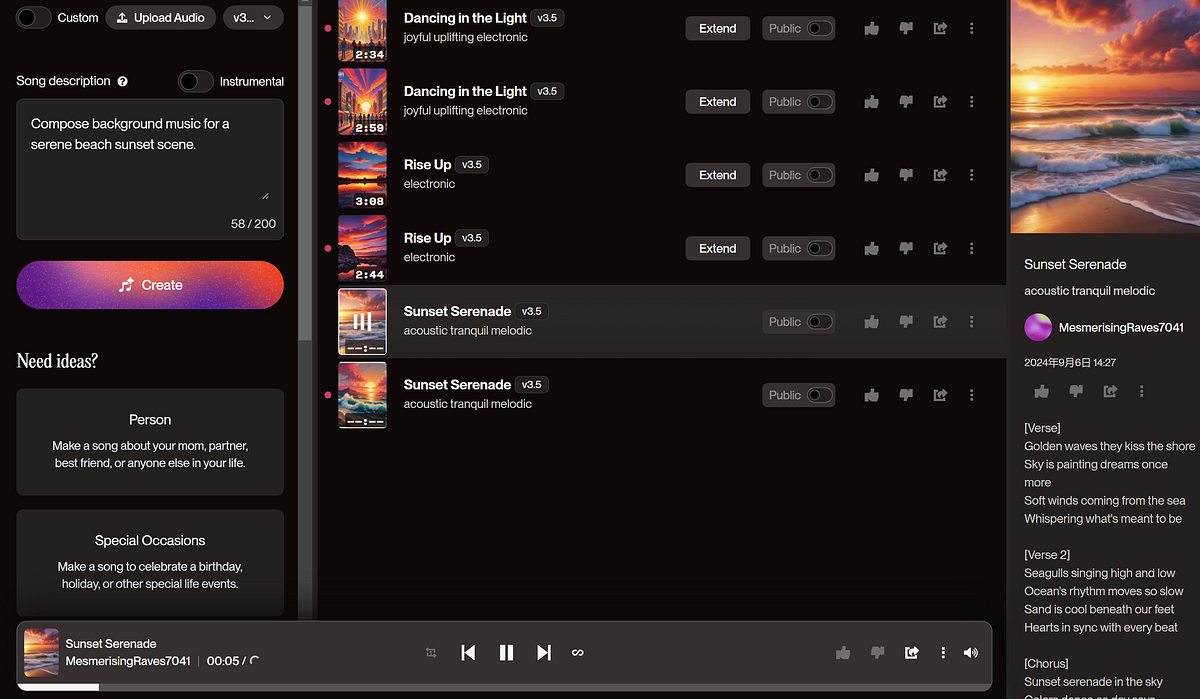
Cultural and Style Fusion
- Create a new piece that blends traditional Indian music with modern pop elements.
Theme and Story
- Compose a song about pursuing dreams, featuring an uplifting melody.
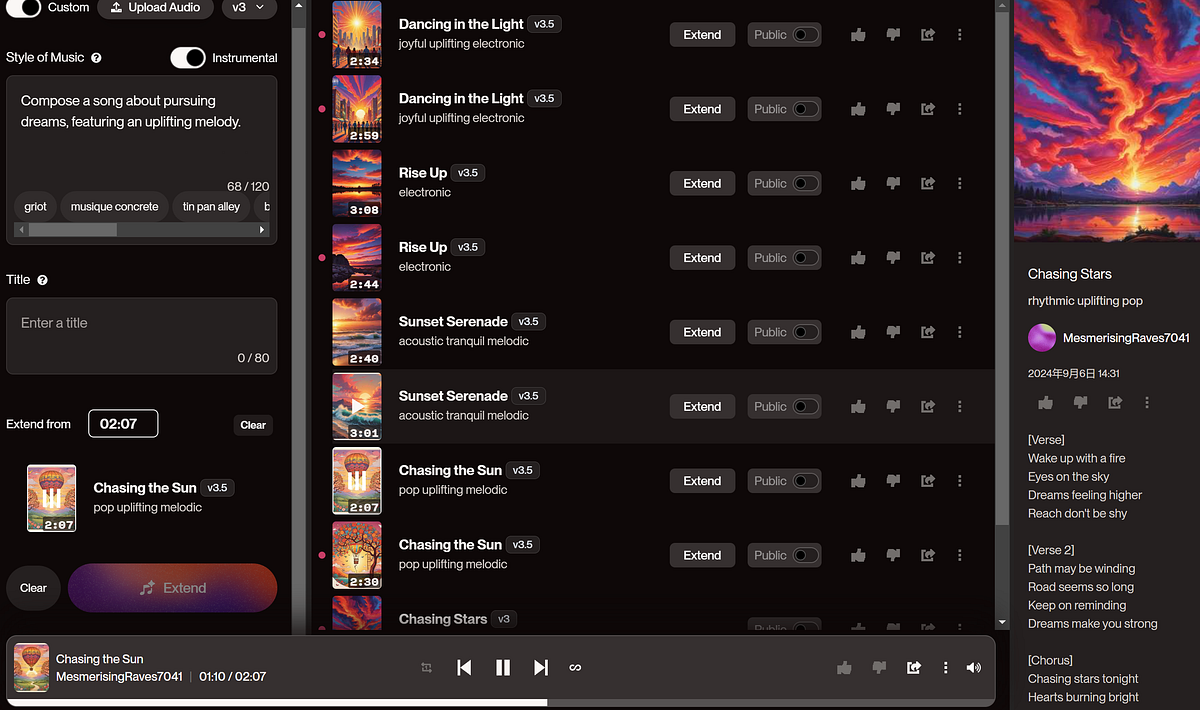
PermalinkHow to Crafting Your First Suno Prompt
Crafting your first Suno prompt is simple. Choose the track’s main parts and a music genre you like. Decide on the mood — cheerful, sad, or dark. Consider the instruments to include for your ideal track.
PermalinkSelecting Your Music Genre or Style
The type of music you choose influences Suno’s music creation. Consider your mood or the emotions you want to convey. Explore rock, jazz, electronic dance, R&B, or “folktronica” for diverse results. Step out of your musical comfort zone and let Suno surprise you with unique blends.
PermalinkIncorporating Cultural and Emotional Elements
Adding emotional elements to your Suno prompt can enhance your music. Incorporate instruments, rhythms, or vocal styles from specific cultures. Including emotions like “uplifting,” “melancholy,” “joyful,” or “intense” in your prompts helps the AI capture a desired feeling in the music. Detailed prompts lead to deeper and more engaging music creations.
PermalinkFine-Tuning with Instruments and Rhythms
Once you know the genre, style, and mood, refine your prompt. Specify the instruments and rhythms you desire — percussion, strings, guitars, or piano sounds. Be specific with choices like “saxophone,” “cello,” or “808 drums” for a modern touch. Consider tempo (BPM) for energy or calmness. Clear details work best with Suno. Experiment with various mixes to achieve your desired sound.
PermalinkUsing Tips for Better Results
Context Recognition: Suno frequently identifies specific words such as “Chorus,” “Verse,” etc., as section titles. Even if the formatting of these names is altered, Suno may still comprehend them.
Testing and Adjusting: Be patient and test various formats to see what works best. Sometimes, even slight changes in prompt format can yield better results.
Using AI Tools: Utilize different AI tools to create prompts that can better guide Suno, such as employing Meta’s Llama 3.1 405B to generate a prompt tailored to a particular music genre.
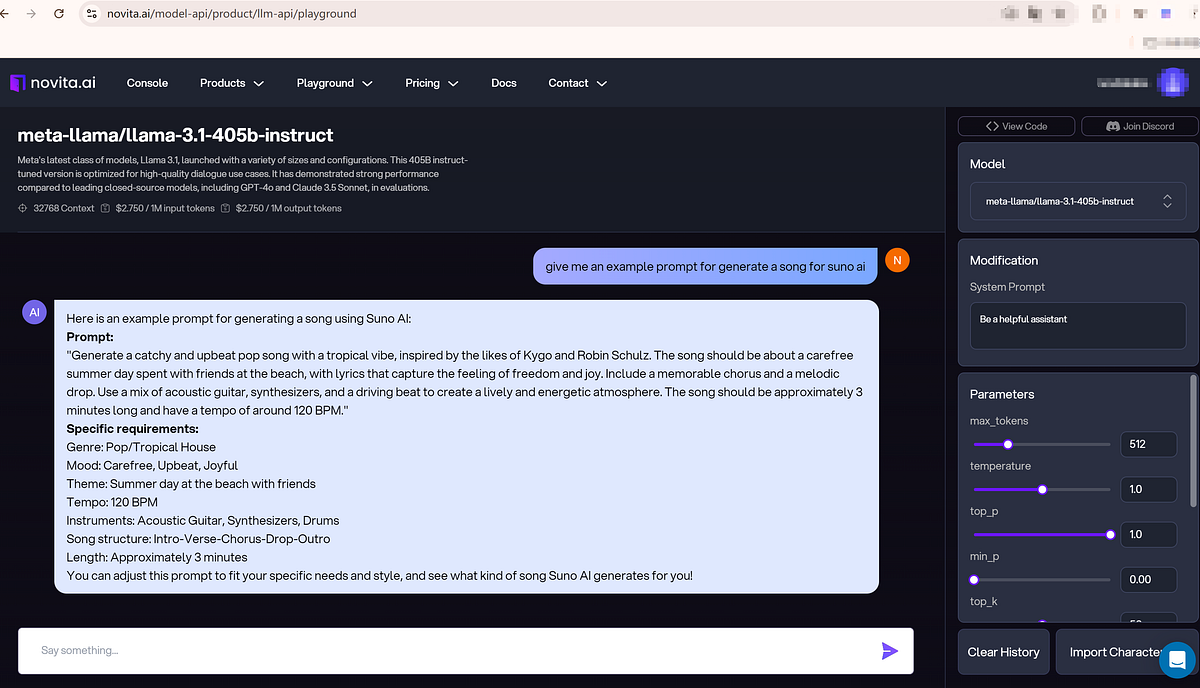
PermalinkHow to Develop an AI Prompt Tool for Suno Prompts
Novita AI stands out as the ideal choice for integrating LLMs into your AI music prompt generation tool due to its powerful infrastructure and cutting-edge models. Offering state-of-the-art LLMs like Llama 3.1 and Gemma-2–9b-it, Novita AI ensures high-quality text generation, which is crucial for creating dynamic and creative music prompts. Their platform is designed to be developer-friendly, providing seamless API access and cost-efficient GPU instances, allowing you to scale effortlessly as your tool grows. Additionally, Novita AI’s focus on performance, reliability, and customizability ensures that you get the best-in-class solution for any LLM-based project.
PermalinkStep-by-step Guide to Develop Your AI Music Prompt Generator
Step 1. Define Music Prompts Scope: Identify the genres, styles, or themes the tool will support for music generation.
Step 2. Select an LLM: Choose a suitable LLM capable of generating creative music-related prompts.
Step 3. Develop Backend: Build a backend to handle user inputs and connect with both the LLM and Suno.
Step 4. Design UI/UX: Create an intuitive user interface where users can select musical preferences or input text for prompts.
Step 5. Integrate LLM:
Sign in to get an API key at Novita AI: Create a Novita AI account and obtain a key at Novita AI key management. You will get free vouchers upon your first log in.
Install Required Libraries: Install necessary libraries in your development environment
API Integration: Use Novita AI’s API documentation to understand the format for sending requests to their LLM models.
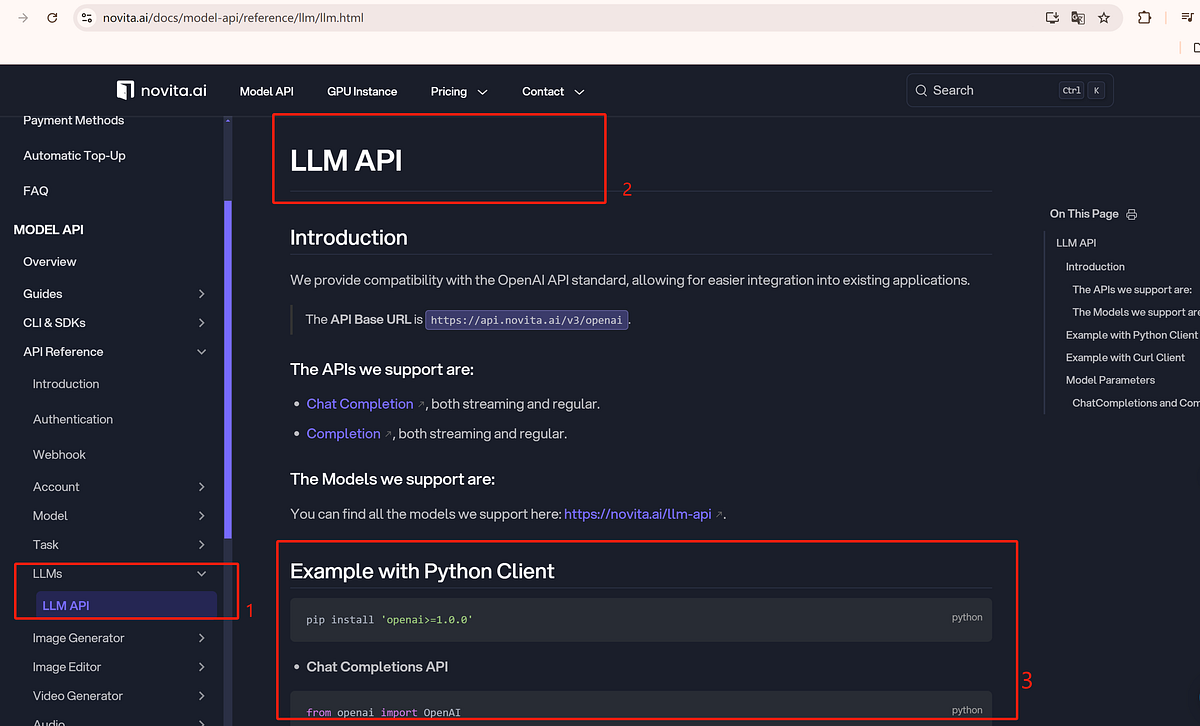
- Set Parameters: Configure parameters such as temperature, max tokens, and top_p to control the LLM output style and creativity.
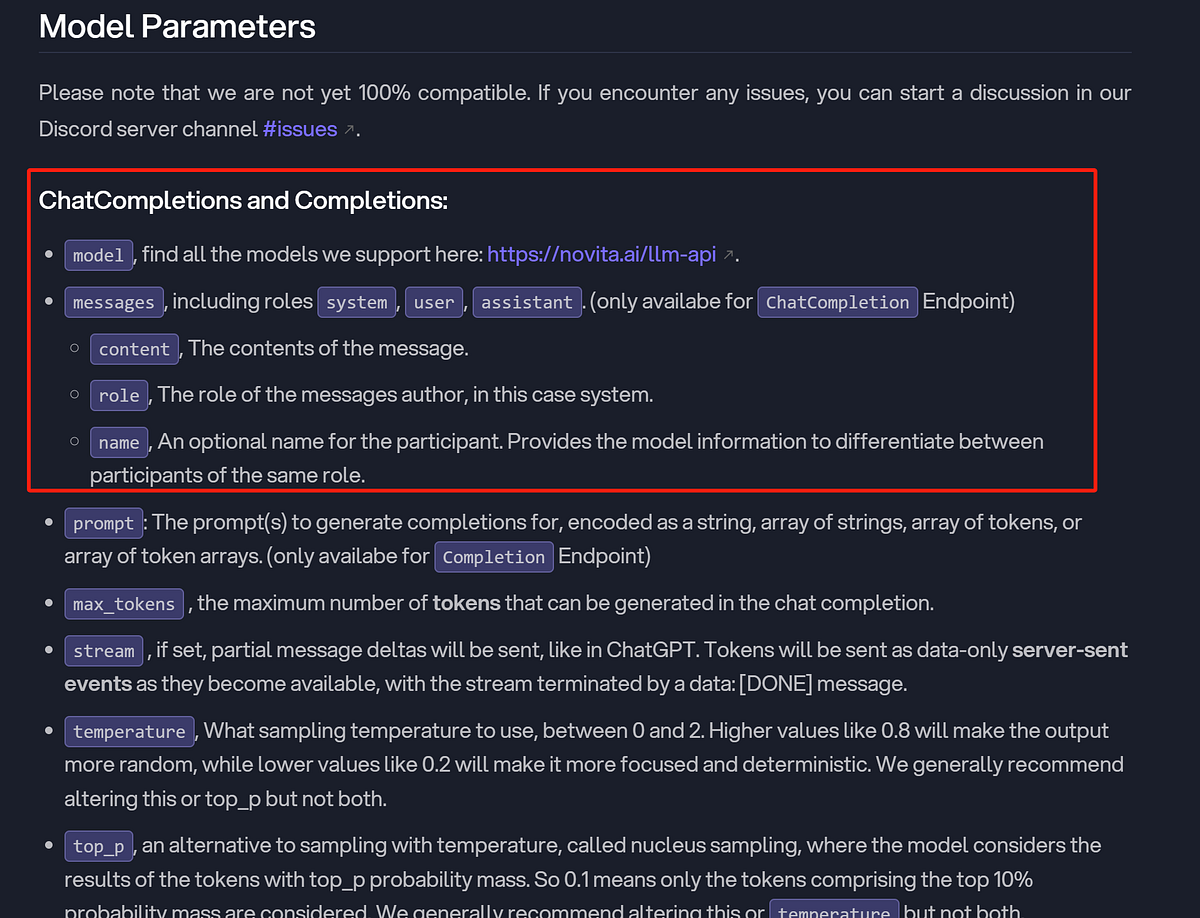
- Test LLM Output: Connect the LLM to generate music prompts based on user preferences or random creative inputs.
Step 6. Tune LLM Outputs: Refine the LLM to generate prompts that translate effectively into music styles supported by Suno.
Step 7. Audio Preview: Implement a feature to let users preview generated music tracks.
Step 8. Testing and Refining: Test various prompt inputs, tune outputs, and optimize the quality of generated music.
Step 9. Deployment and Scaling: Host on a scalable cloud platform (e.g., Novita AI) for wider accessibility.
PermalinkConclusion
In conclusion, using Suno Prompt Examples can help improve your creativity in music creation. By adding cultural elements, emotions, and different rhythms, you can make unique and interesting pieces. It’s important to create a good environment and use the right tools for prompt creation. Keep in mind that anyone can use Suno Prompt Examples, no matter their musical background. Embrace this new way to make music and discover your artistic side. Explore the many options these prompts provide and let your creativity fly!
PermalinkFAQs
PermalinkWhat Are the Best Practices for Beginners?
For beginners checking out Suno, begin with simple prompts that mention the genre, mood, and instruments. Use existing examples as models.
PermalinkCan I Combine Multiple Genres in One Prompt?
Yes, you should mix genres in a Suno prompt! Combining types like “jazz” with “funk” or “orchestral” with “electronic” can create interesting and surprising music. Try different mixes and find what you enjoy.
PermalinkHow to Get the Best Results from Suno Prompt Examples?
Creating smaller sections can result in better quality and smoother transitions for the subsequent parts. Experimenting with different rhythms and tones can help find the most suitable music for the lyrics.
PermalinkCan Anyone Use Suno Prompt Examples?
Suno prompt examples are user-friendly for all, regardless of musical expertise. Join the vibrant Suno communities to learn, share ideas, and nurture creativity.
Originally published at Novita AI
Novita AI is the All-in-one cloud platform that empowers your AI ambitions. Integrated APIs, serverless, GPU Instance — the cost-effective tools you need. Eliminate infrastructure, start free, and make your AI vision a reality.
